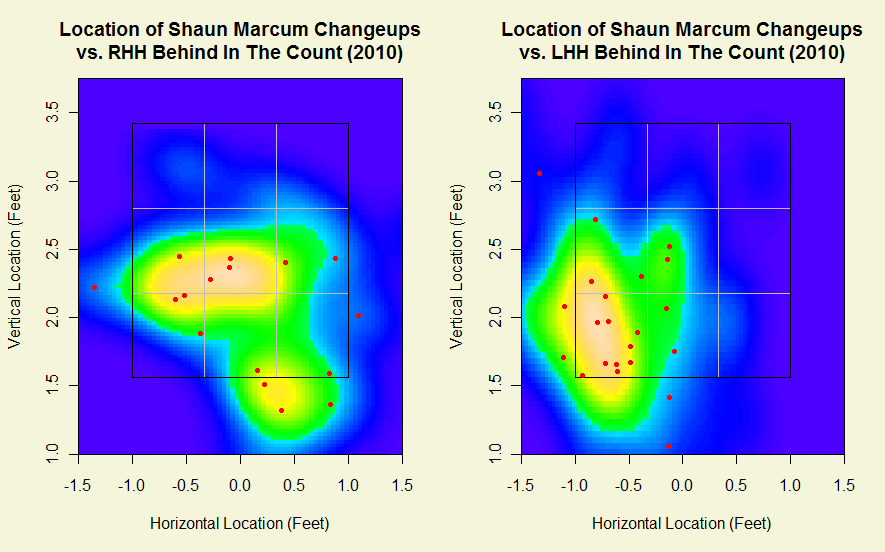Shaun Marcum’s Fastball and Changeup
Baseball fans know about Zack Greinke, the Brewers’ newest addition to a much-improved rotation, but the performance of lesser known Shaun Marcum is arguably just as important to a successful Milwaukee season. The expectations for Marcum may not be as great as that of Greinke, but Brewers fans should be glad to know that Marcum isn’t too shabby a pitcher himself. In 195.1 innings, Marcum struck out 165 and walked 43, good for a 3.74 FIP, a figure better than that of Jonathan Sanchez and Tim Hudson. And Marcum does this with a high-80s fastball.
Marcum mixes two fastballs, a changeup, cutter, slider, and curveball, but primarily relies on his fastball and changeup. He throws a fastball about 45% of the time, but it’s the usage of his changeup that’s the key to his success at getting whiffs. He throws a changeup about 26% of the time, fourth in the Majors. Of Marcum’s breaking balls and offspeeed pitches, his changeup is the most valuable because of its funny movement, leading all of baseball in changeup runs above average.
The right-handed pitcher makes up for his lack of fastball velocity by working both sides of the plate, mixing in a good cutter as well depending on the situation. We’ve PITCHf/x’d to death a certain pitcher in the past with uncanny cut fastball control, so I thought we’d give Marcum that same treatment here. Here are several graphs of Marcum’s fastballs in different count situations. The black points represent Marcum’s cutter:
Marcum’s cutter breaks sharply and slightly away from right-handed hitters. When visualizing these graphs, remember that the colors represent density levels in one graph that can be compared with that of another. The rule of thumb is that the more concentrated the “yellow spot” is, the more telling Marcum’s location is.
On the first pitch to RHH, Marcum will typically work away with his fastball and hit the outer half of the strike zone most of the time with his cutter. He works the batter similarly when behind in the count. However, when ahead in the count, Marcum isn’t afraid to throw his fastball down the middle or his cutter away and out of the zone. When against LHH, Marcum locates his fastball outside as well (glove side for the pitcher) but rarely uses his cutter (using it 17% of the time against RHH, 9% against LHH).
Here’s a look at Marcum’s changeup location in the same count situations. The red points in the following graphs represent swinging strikes on changeups:
Marcum rarely uses his changeup on the first pitch, but isn’t afraid to throw it behind or ahead in the count against both batters. Opposite to that of his cutter usage, he throws his changeup much more frequently against LHH, using it 16% of the time against RHH and 31% of the time against LHH. When behind in the count, Marcum will work outside to LHH and hit the lower outer corner of the strike zone. When ahead in the count, he will throw the changeup lower and out of the zone, getting a significant number of his whiffs down and outside.
These graphs tell us that Marcum works right-handed batters much differently than left-handed batters. In general, Marcum’s best out-pitch is his changeup, which he uses to whiff 27% of both batters. He uses his fastball as well as his breaking balls to get called strikes. Against same-handed batters, the right-handed pitcher diversifies his pitch repertoire with five or six pitches by increasing the usage of his cutter and slider. Against opposite-handed batters, Marcum usually sticks to a two-pitch fastball/changeup arsenal with an occasional curveball or cutter.
Marcum’s approach doesn’t achieve perfect results, as he does get some weird platoon splits. Amazingly, left-handed hitters batted .190/.233/.299 off Marcum against a two-pitch tandem. Right-handed hitters, however, hit .298/.345/.514. You would expect the opposite split for a right-handed pitcher (John Danks is an example of a left-handed pitcher who performs better against opposite-handed hitters). Whether or not Marcum can sustain this split or improve his performance against RHH remains to be seen. What I do know is that I look forward in 2011 to seeing how Marcum’s changeup stacks up against the NL Central’s batting lineups.
Albert Lyu (@thinkbluecrew, LinkedIn) is a graduate student at the Georgia Institute of Technology, but will always root for his beloved Northwestern Wildcats. Feel free to email him with any comments or suggestions.






He plays baseball